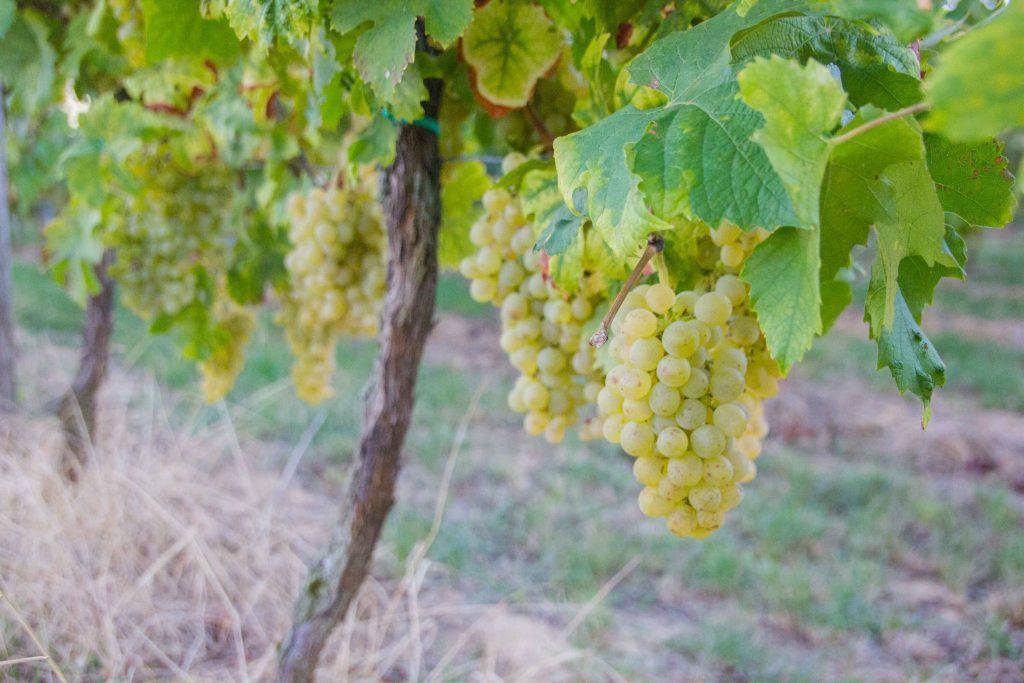
Grapes
Soil:
Grape growth is possible on almost any types of soil; however, for a successful cultivation elements like average fertility, sandy loam and adequate amount of organic matter are important. The recommended pH for the soil is 6.5-7.5.
PLANTATION SEASON
Jan-Feb
Orchard Layout
Layout of plants:
Trellis system: Plant -Plant 7 ft, Row-Row 10 ft
Pruning Season:
Dec-Jan
Suitable Areas
Swat, Malakand, Chitral, South Waziristan, Bajour, Orakzai, FATA
Varieties
Sundar Khani, King’s Ruby Seedless, Askari, Hussaini, Black Prince, Early White, NARC black, Cardinal, Thompson seedless, Autumn Royal, Perlite, Sultanina C, Vitro black, Red Glob
Fertilizer
NPK: 200:150:250 g
Harvesting Time
June-July
Production per vine
8-10 kg fruit
Diseases of Grapes
Diseases
Identification
Depending on the incubation period and leaf age, lesions are yellowish and oily or angular, yellow to reddish and brown and limited by the veins. The fungus can be identified once its sporulation appears as a delicate, dense, white, cottony growth in the lesions.
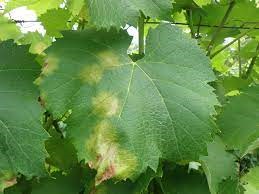
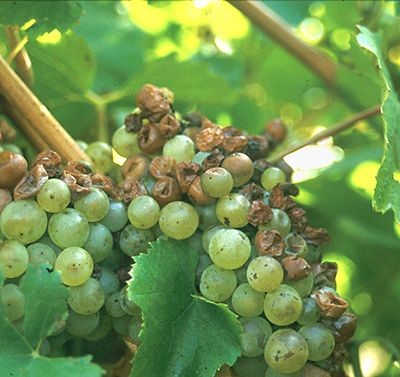
Management
Cultural Control
Preventive management can be conducted through effective soil drainage and reduction of sources of overwintering inoculum. When using sprinkler irrigation, extend the interval between irrigations as long as possible.
Chemical Control
To prevent downy mildew, the fungicides can either be preventive or curative. (cymoxanil + mancozeb, Copper hydroxide, Azoxystrobin.).
Anthracnose (Bird’s eye rot) Elsinoe ampelina
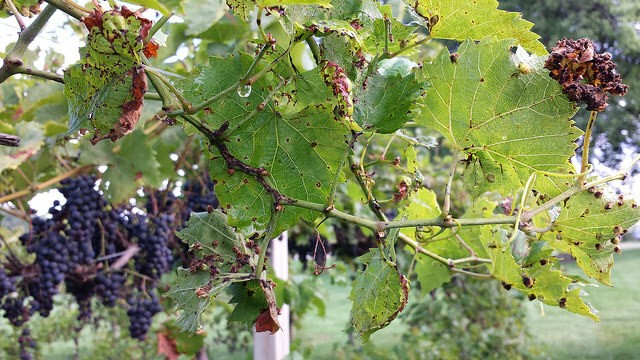
Identification
To identify this disease, farmer must be able to to spot dark red lesions on grapes; sunken grey lesions with a darker edge on grapes; lesions on the leaves causing leaf to curl; lesions on shoots. These tend to cause damage, killing parts of the plant; lesions may also be present on tendrils, fruit stems, and leaf stems.
Management
Cultural Control
It is recommended to plant less susceptible varieties of grapes; application of Bordeaux mixture or other appropriate fungicide while vines are dormant may be necessary.
Chemical Control
Chlorothalonil, Coper hydroxide, thiophanate-methyl
Armillaria root rot Armillaria mellea
Identification
Weak, short shoots; white fungal mats under the bark at the soil line; unproductive vines; rapid wilting
Management#
Cultural Control
Fumigation may be needed on soils known or suspected to have carried the disease.
Plant less susceptible varieties; conduct a proper vegetative growth control on the vines.
Chemical Control
Propiconazole, Metalaxyl+Mancozeb
Botrytis bunch rot (Gray mold) Botrytis cinerea

Bunch rot symptoms on fruit
Identification
Spot brown lesions on the stem early in the season, grapes covered with a grey to tan powder or stems and grape clusters shrivel.
.
Management
Cultural Control
Plant less susceptible varieties; reduce amount of vegetative growth on vines and do not over fertilize. Use suitable trellises to increase air circulation in the canopy and expose grape clusters to sun.
Chemical Control
Chlorothalonil, Iprodione, Azoxystrobin
Dieback (Eutypa dieback.) Eutypa lata
Identification
This disease can be spotted if the leaves are stunted and withered, curled into a cup shape, visible dark cankers on wood and if the cross section of wood reveals wedge-shaped discoloration.
Management
Cultural Control
Use resistant varieties.
Chemical Control
Use of an appropriate fungicide on pruning wounds can prevent the fungus from entering the plant which is why fungicide should be applied at time of pruning.
Thiophanate methyl, Copper hydroxide, Tetraconazole.
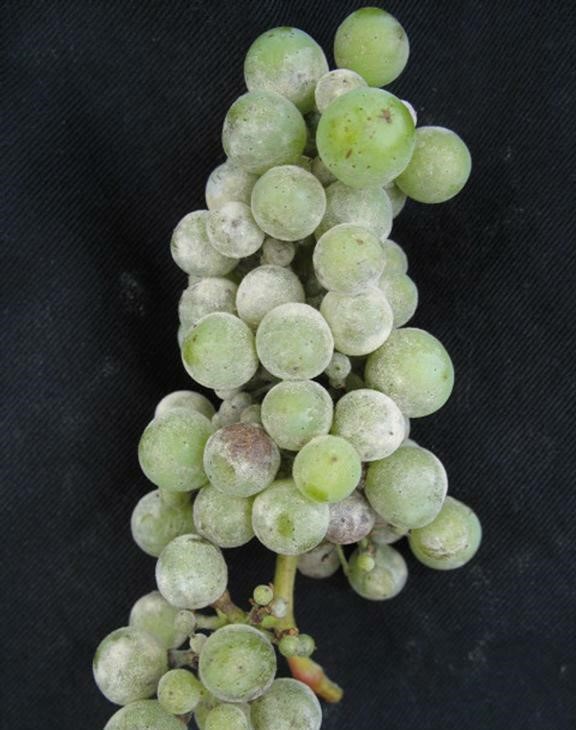
Powdery mildew symptoms on fruit
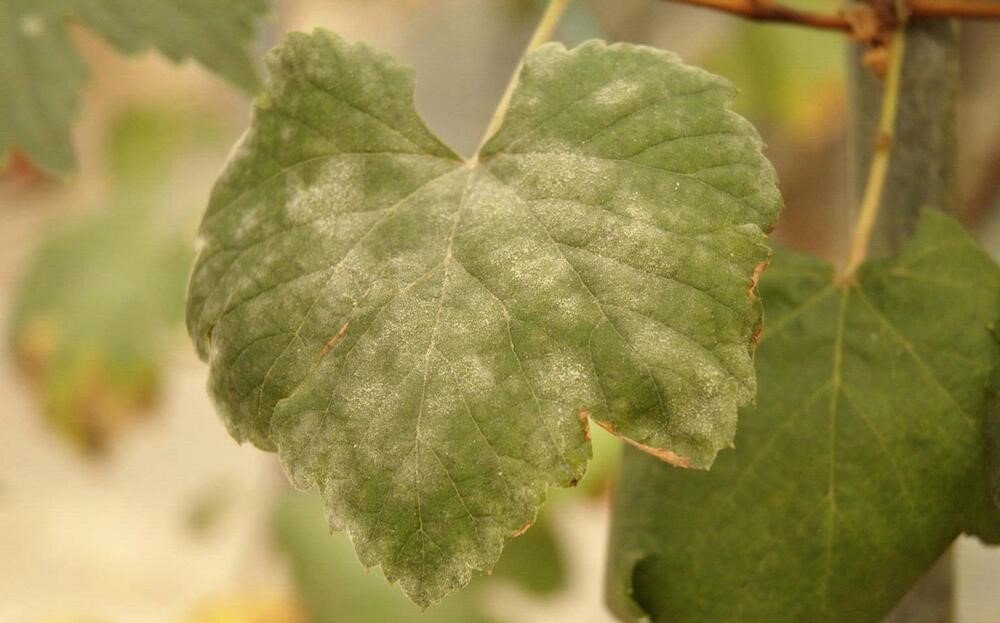
Powdery mildew symptoms on leaf
Identification
To identify this diseases, look for red patches on canes and yellow patches on top of the leaves. There may also be white powdery growth on leaves and on the fruit alongside brown to black irregular blotches on the shoots.
Management
Cultural Control
Plant vines should have access to good air circulation and sun exposure. Use of a training system that promotes air circulation through the canopy is suggested to farmers.
Chemical Control
Apply Sulphur or Copper-based fungicide
Category: Bacterial
Black rot Guignardia bidwellii
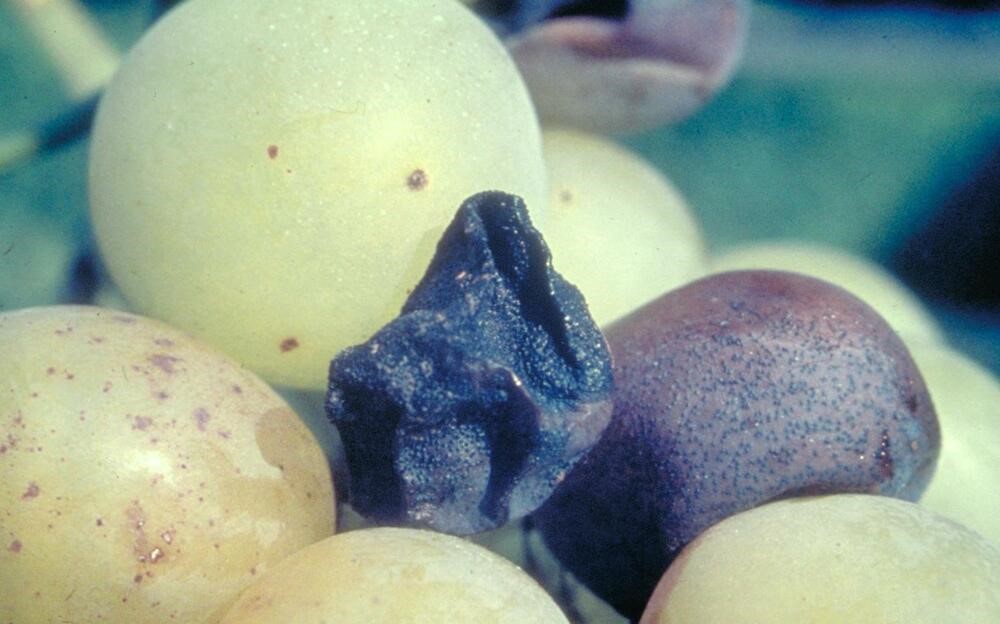
Black rot symptoms on fruit
Identification
Farmers can find this disease by spotting brown lesions on the leaves that develop black dots (pycnidia). If the grapes have light spots that eventually form pycnidia, the grapes are expected to harden and turn black, while still remaining on the vine.
Management
Cultural Control
Remove all previously dried up fruit from the vines during dormant pruning and cultivate the soil during bud break to reduce inoculant.
Chemical Control
Application of appropriate fungicides can help control the disease.
Cymoxinil+Mencozaib
Crown gall Agrobacterium Vitis
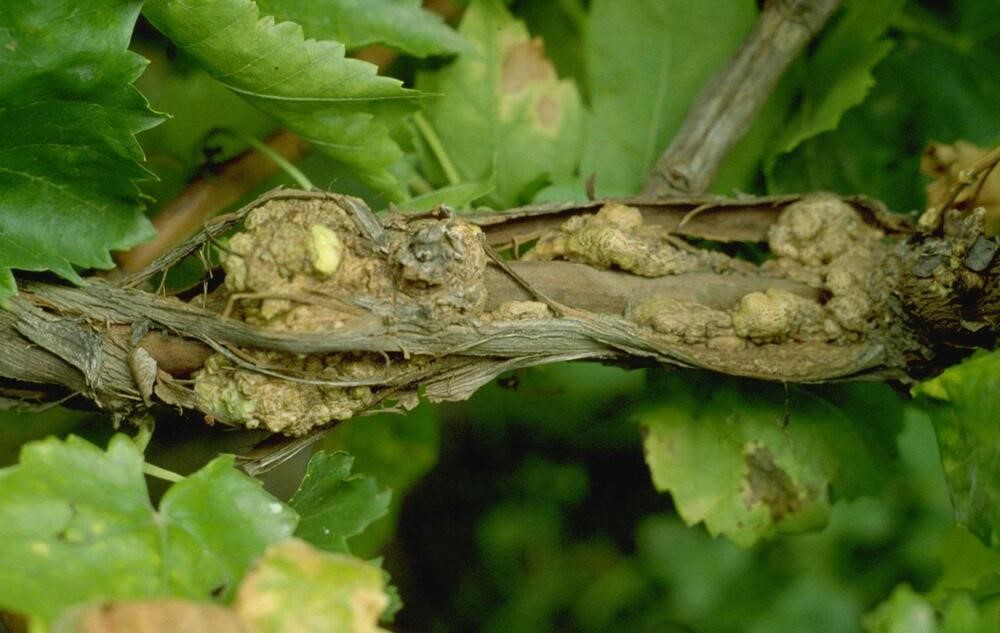
Galls on grape vine caused by crown gall
Identification
Galls on vines, wilting and yellowing of the canopy, drying grapes or collapsing plants are a sign of a disease spread.
Management
Cultural Control
- All equipment must be sanitized regularly to avoid injuring plants. Heat treatment of planting material can also help get rid of pathogens before planting.
Chemical Control
Currently available products (Chemical Treatments) only treat the symptoms of this disease and are not effective to bacterial infections.
Insect Pest
Pierce’s disease Xylella fastidiosa
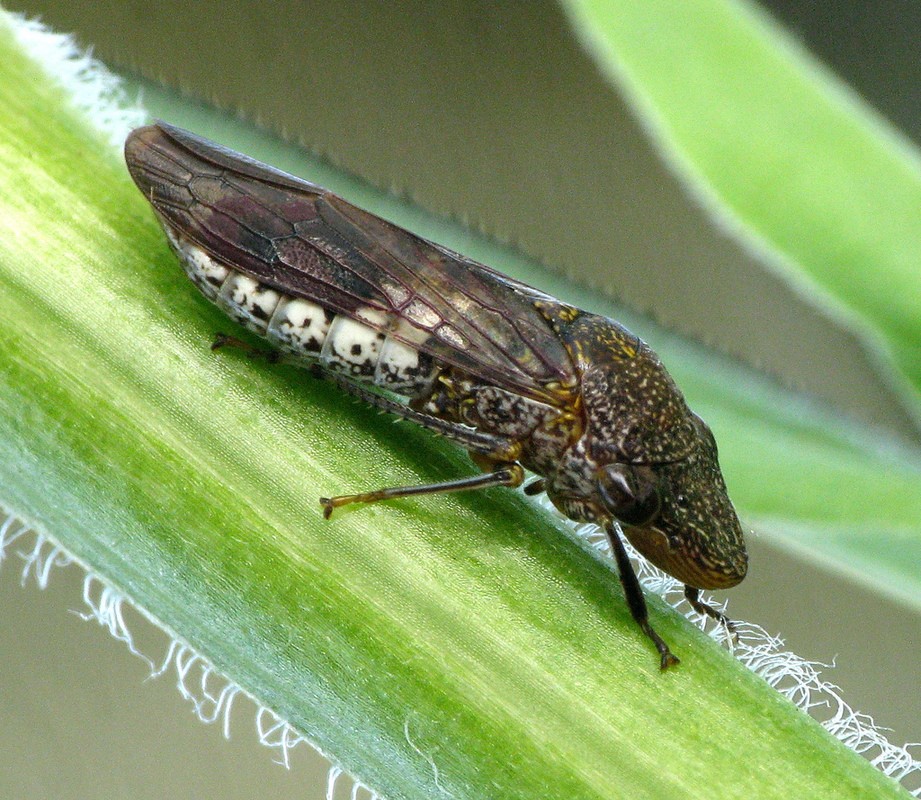
Glassy-winged sharpshooter: a vector of Pierce’s disease
Identification
Look for yellow to red leaf edges, dry leaves with death in concentric rings, consistent leaves falling but petiole remaining attached to vines or when fruit is dry and shrivelled.
Management
Application of appropriate insecticide in areas adjacent to plantation will reduce the number of sharpshooters reaching the vines during spring. Monitor vines with mild symptoms and remove them as soon as the symptoms are visible.
Young vine decline Phaeoacremonium spp.
Togninia minima,
Togninia californica
Identification
Symptoms of this insect attack are small yellow spots between leaf veins, leaves dropping or round brown/purple lesions with dry cracks on fruit.
Management
It is best not to stress vines which why adequate irrigation must be provided while avoiding over-fertilizing. Do not harvest the grapes until the vines are at least 3 years old.
Black vine weevil Otiorhynchus sulcatus
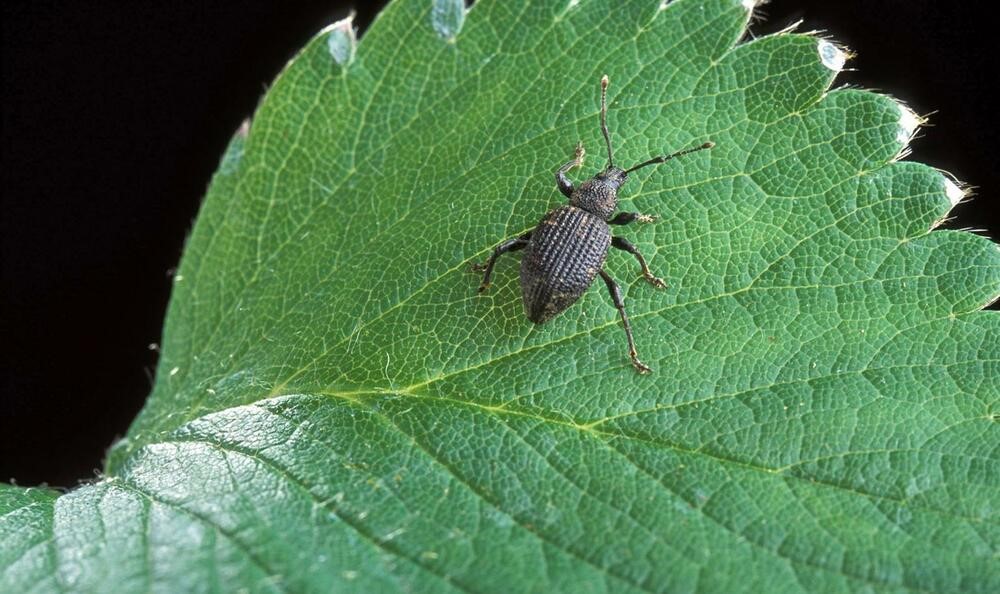
Black vine weevil
Identification
Damage to stems, leaves, buds, flowers or loss of plant vigor are the main symptoms of the Black Vine Weevil insect.
Management
Grow a cover crop such as red fescue to distract insects from the grape vines.
Grape cane girdler Ampeloglypter ater
Identification
Spot holes encircling the cane or punctures in cane.
Management
To avoid adult insects during summers, pruning out infested shoots below girdle insects or start spraying to control adult populations.
Grape mealybug Pseudococcus maritimus
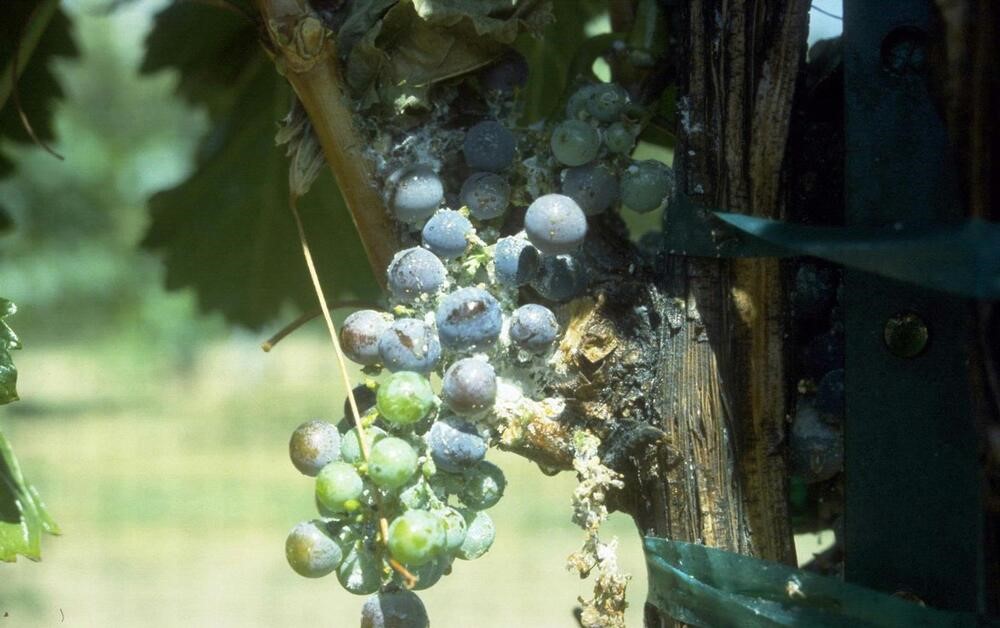
Grape mealybug damage to fruit cluster
Identification
When sugary secretions by the insect drop onto fruit and encourage growth of mould leading to a loss.
Management
Ant populations must be controlled to encourage populations of mealybug and applying appropriate insecticide is also suggested.
Japanese beetle Popillia japonica

Adult Japanese beetle
Identification
These Japanese beetles are mostly present from June through September of each year. Japanese beetle adults are metallic green or greenish bronze in colour with reddish wing covers and several white spots near the abdomen. Japanese beetles are active during the day, feeding on many species of trees, shrubs and flowers causing serious damages to roses, linden trees, grapes and others.
Management
If beetles were a problem in the previous year, use floating row covers to protect plants or spray kaolin clay. Adult beetles can be spotted, hand-picked from plants and destroyed by placing in soapy water. To reduce the number of overwintering grubs, parasitic nematodes can be applied to soil. Insecticides (carbaryl, triclorfon, midacloprid, thiamethoxam) can also help reduce beetle populations.
